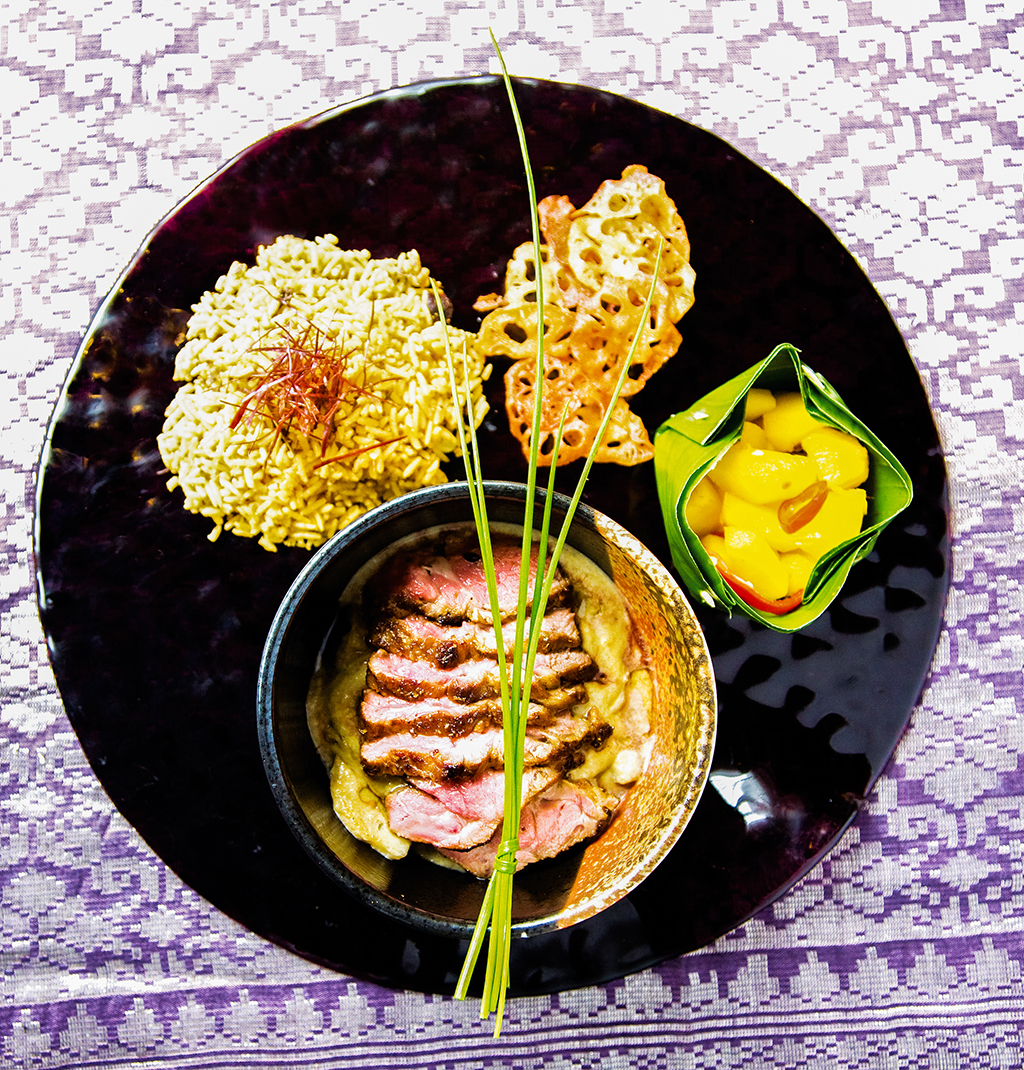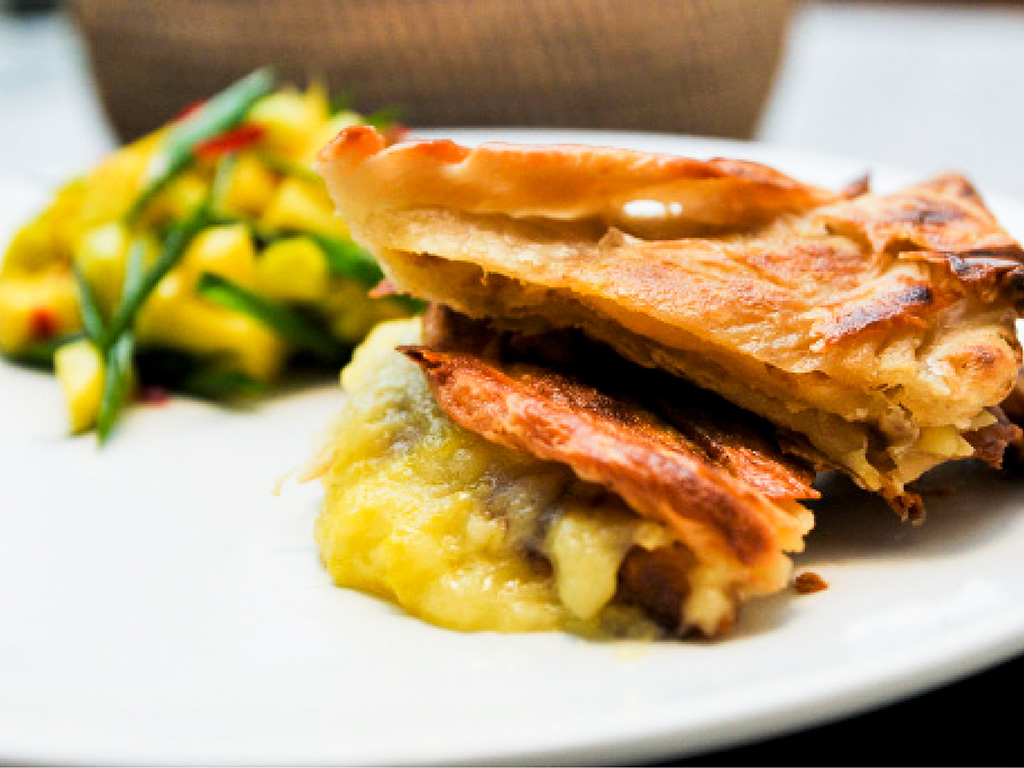
This lamb neck fillet recipe is a complete meal I used to serve in my restaurant. It is one of my most important creations. In 2007, it won the “UK Best Dishes Award” by Restaurant Magazine Awards in the curry category, throughout the United Kingdom.
I still cook and serve my lamb neck fillet dish until today and it remains a favourite amongst family and friends. I hope it will be your new favourite dish too when you try and make it, be it today, tomorrow, or forever!
This dish has very contrasting components, yet when served together, it becomes an innovative meal that I promise will whet your appetite.
Preparing the satay marinade
Ingredients
- 15 shallots
- 3 inches young ginger
- 3 tbsp vegetable oil
- 2 tbsp sweet soy sauce
- 1 tbsp coriander seeds – dry roasted & pounded
- 1 tbsp cumin – dry roasted & pounded
- 1 tbsp coconut sugar or molasses
Method
- Pount together shallots, young ginger and coconut sugar with a pestle and mortar.
- Mix all ingredients together to use as a marinade.
Chef’s advice
This satay marinade is also perfect for marinating regular satay, as well as chicken, rabbit, lamb or duck. It is not suitable for seafood as its flavour is quite strong.
Preparing the lamb neck fillet
Ingredients
- 4 pcs lamb neck filets – excess fat trimmed
- The satay marinade prepared earlier
- A little cooking oil for frying
Method
- In a bowl, marinade lamb neck fillets with satay marinade.
- Cover the bowl with plastic wrap and marinade overnight in the refrigerator.
- When you’re ready to cook, heat a little bit of cooking oil on a skillet on high heat. ½ tbsp cooking oil is normally sufficient.
- Add in lamb neck fillets to seal the surface of the fillets until evenly brown. Don’t forget to seal the other side too. If your filets are quite large and can’t fit onto your skillet all at once, you can also seal them one by one. Add a little bit more cooking oil as needed.
- Heat your oven to 180°C.
- Arrange sealed lamb neck fillets on a baking tray. When your oven is hot enough, put your fillets into the oven for 8 to 10 minutes, turning it over four times, or roughly every two minutes.
- Once cooked, rest the lamb neck fillet for 5 minutes before slicing thinly.
Chef’s advice
Sealing is a process of frying meat with a little bit oil until the surface browns. The fire has to be hot so when the meat touches a hot skillet, the surface will cook immediately, causing the meat’s juices to remain trapped. This results in a meat that will retain its moisture even when cooked for longer periods.
Lotus root kurma preparation
Ingredients
- 200g lotus root – peeled, diced & steamed or boiled until cooked through but remains firm and crunchy
- 2 pandan leaves – knotted
- 1 litre water or vegetable stock
- 300ml coconut milk (from 1 coconut)
- Oil for sautéing
- Salt to taste
Kurma paste ingredients
- 9 shallots
- 5 cloves garlic
- 5 tbsp beef kurma powder serbuk kurma daging
- 5 large green chilies – seeds removed
- 2 inches ginger
- 1 tbsp coriander seeds – dry roasted
- 1 large onion
- 100gm coriander leaves – sliced along with the stems
- A little bit of water for blending
Method
- Blend on kurma paste ingredients until it becomes a paste.
- Heat oil in a pot.
- Add kurma paste and sauté until the spices have cooked. Pour water or vegetable stock in small amounts to ensure the paste doesn’t burn.
- Add the rest of the water or vegetable stock along with the knotted pandan leaves. Bring to a boil.
- Add coconut milk and lotus roots. Let it come to a boil once again but remove your pot immediately at the first boil.
- This dish is ready to serve.
Chef’s advice
I always have prepared spices kept in air-tight containers in my kitchen. This way, I don’t have to worry about dry-roasting them when I need to use them. However, spices will lose their scent and flavour over time, so be sure to only use spices that were dry-roasted less than a month ago.
For a healthier version of this recipe, reduce the use of coconut milk from one whole coconut to half a coconut. Or, replace with low fat milk (the flavour profile will be a little different compared to using coconut milk).
I learned the technique of using pandan when cooking kurma from Aunty Margaret, who was like a foster mother to me as well as the Indian food chef in my restaurant in Langkawi back in 1994.
Cooking Mush pilaf with fresh black peppercorns
This pilaf rice recipe is one I borrowed from Mush, a good friend of mine with Pakistani-British origins. He is an expert at Pakistani food. This rice pairs very well with curry. I added some fresh black peppercorns to this recipe to make it a little different. Thank you, Mush.
Ingredients
- 200g Basmathi rice
- 250g water
- 1 large brown onion – finely shredded
- 5 black cardamom
- 5 cloves
- 2 star anise
- 1 cinnamon stick
- 1 tsp mustard seeds
- 1 tsp turmeric powder
- 1 tsp aniseeds
- 1 tsp coriander seeds
- 1 tbsp fresh black peppercorns (which are still green in colour) – stems removed
- 1 bay leaf
- 1 tbsp mixture of ghee and vegetable oil
- A pinch of salt
Method
- Soak Basmathi rice for a short while and then rinse until the water runs clear.
- Head the ghee and vegetable oil mixture in a pot and sauté mustard seeds until they begin to pop.
- Immediately add in onions.
- Add in the rest of the spices, excluding the fresh peppercorns.
- Add water, bay leaf and salt.
- Bring to a boil.
- Add rice and stir it through slowly to ensure the rice grains stay whole.
- Turn the heat down and cover your pot.
- Stir slowly from time to time, but keep your pot covered at all other times until the rice is cooked.
- Finally, add in the fresh black peppercorns, give it a stir, close the pot and turn off the heat.
Chef’s advice
Be gentle when preparing pilaf rice. Basmathi needs to be handled carefully when rinsing and stirring as soaked Basmathi can easily break, resulting in rice that is brittle and light. Broken rice will release its starchy contents when cooked, causing it to become sticky. That said, Basmathi has a fairly low starch content compared to other types of rice. Also, do note that the water required for cooking your Basmathi may differ a little depending on the type of Basmathi used.
Preparing pickled water chestnuts
Ingredients
- 25 water chestnuts – peeled and sliced in half
- 1 tsp turmeric powder
- 2 red chilies – deseeded & sliced thinly
- 150gm white sugar
- 300ml white distlled vinegar
- 500ml water
- A pinch of salt
Method
- Except for the water chestnuts, cook the rest of the ingredients in a pot until it boils.
- Turn the heat down to low and simmer until the liquid thickens a little.
- Add water chestnuts to the liquid and turn off the heat.
- Let it cool.
Chef’s advice
Water chestnuts can also be replaced with different fruits such as young mango, jicama, and cucumber, for example.
My lamb neck fillet recipe is definitely a winner. What enticed the jury towards this recipe is the way it combined Malay and Arabic flavours (through the satay marinade), Indian (kurma), Pakistani/Persian (pilaf) and Chinese flavours (water chestnuts and lotus roots), resulting in a fusion dish that perfectly reflects the slogan ‘1 Malaysia’.
This lamb neck fillet recipe along with my other recipes can be found in my book, Ikan di laut, asam di darat. My new book Ke mana tumpahnya kuah is also now available. Get your hands on a copy of both books from my café, The Canteen by Chef Adu, or my Facebook page.



